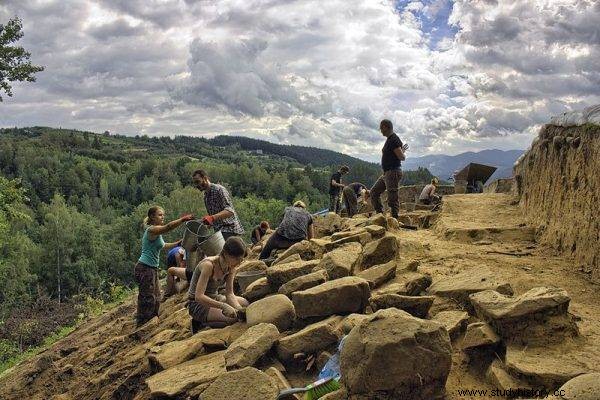This is one of the oldest examples of utility stone architecture in Europe outside the Mediterranean area. Who built this stronghold over 3500 years old?
When ancient Egypt was ruled by the pharaohs, and King Hammurabi ruled in Babylon, in the Dunajec valley, in today's Lesser Poland, on a picturesque hill among forests, called Mount Zyndram , the mysterious newcomers have established an estate. They built a massive stone wall around it . The defensive settlement from the Sądecczyzna Region is one of the oldest examples of utility stone architecture in Europe, apart from the Mediterranean basin. Scholars to this day wonder what kind of people built this stronghold over 3500 years ago.
The first excavations on the hill in Maszkowice near Łąck in the Nowy Sącz poviat were carried out in the 1960s and 1970s. Dr. Maria Cabalska from the Jagiellonian University dealt with them. Later, the so-called Zyndram Mountain has been tested many times.
Mount Zyndram without Zyndram
The name of the 400-meter hill comes from a local legend. According to it, the knight Zyndram of Maszkowice, of the Słońce coat of arms, had his seat here. He was a trusted man of Władysław Jagiełło. He participated in the Battle of Grunwald. He dealt with setting up Polish troops before the clash with the Teutonic Knights. He himself led the Krakow banner into battle.

According to it, the knight Zyndram of Maszkowice, of the Słońce coat of arms, had his seat here.
For two centuries it was believed that it was on the above-mentioned hill, therefore called Mount Zyndram, that the knight's castle was located. In 1910, a stone was even placed there to commemorate the 500th anniversary of the Battle of Grunwald. According to local legends, local farmers were supposed to find a sword on the hill. Apparently, fragments of the tower were also discovered. For now, however, science does not confirm that there was ever a medieval castle there. On the other hand, it was definitely established that there were indeed massive walls there. Except that they were created ... over 2000 years before the Battle of Grunwald!
Fortified Hill
For several decades, researchers have known about ancient settlements in this place. The real breakthrough in the research turned out to be 2015, when a layer of prehistoric boulders was found. It turned out to be the remains of a huge, 200-meter wall, up to three meters high and two meters thick. From the north, east and south, it surrounded the houses of the first settlement on the so-called Mount Zyndram. From the west, the hill is so steep that no cover was needed. The fortification was erected without mortar. The stones were placed and matched on top of each other, on the basis of the so-called technique. dry wall.

The eastern gate of the Bronze Age stronghold - condition after partial reconstruction in 2018
The wall protected several dozen houses made of wood and clay inside. A monumental gate decorated with stelae led to the interior from the east. The find has no analogues in the Carpathians and all over Poland. The first utility stone buildings in our country come from the times of Mieszko I. Moreover - generally in Europe (except the Mediterranean Sea) very few similar structures have survived.
People lived behind the mighty fortification. The first settlement was not big. It probably consisted of several dozen houses and farms made of wood and clay. They stretched along the wall, around the main square of the stronghold. They were not residences. The houses were no more than 50 square meters.
Newcomers from the south?
The settlement, the founders of which built a large stone wall, survived for about 200 years. Its history was turbulent. The estate was probably consumed by fire twice. Fortifications and houses were converted. The houses behind the wall were finally abandoned around 1500 BCE A little over 500 years later, a new group of settlers, this time representing the Lusatian culture spreading over vast stretches of today's Poland, expanded and re-inhabited this place. Later, people lived here in the Iron Age and in the so-called the La Tene period (ca. 200-50 BC), when the Celts dominated in Europe. The youngest layer survived the least.
Who built the great fortifications of the oldest human residence in this place? Researchers believe that it could have been done by newcomers from very far - most likely from southern Europe. The wall surrounding the village looks like it was pulled "alive" from one of the archaeological sites in the Balkans or Greece. The builders not only used stone, which was unusual in itself, but also used the same technique.

Works on the archaeological site on Mount Zyndrama
According to archaeologists, those who built the fortress had to come from outside - from the Mediterranean or the Adriatic coast. Similar structures were discovered, for example, in Croatia, on the Istrian peninsula.
A prehistoric trading post?
What were the visitors from the far north doing? It is impossible to answer this question unequivocally. However, researchers speculate that the settlement may have been commercial . It is possible that this is where amber was supplied from the Baltic Sea and it was exchanged for other goods , for example, from southern Europe. The precious amber continued its journey - to the Mediterranean Sea. Certainly, the location of the settlement on the trade route from north to south was not accidental. A steep, hard-to-reach hill was chosen for the construction of the fortified housing estate, allowing a good view of the area.
So much is known about the settlement from Maszkowice today. Excavation research on the so-called Mount Zyndram is still going on. So it is possible that we will soon learn more about the lives of the mysterious settlers over 3500 years ago.
Bibliography:
- Zyndram's mountain in Maszkowice, Archaeological research of the Jagiellonian University (access:23/03/2022).
- Iga Michalec, The mystery of Mount Zyndram. A sensation on a global scale, Sądeczanin.info (access:March 23, 2022).
- Archeology of the Jagiellonian University:defensive settlement on Mount Zyndrama (accessed:March 23, 2022).
- Irena Styczyńska, Zyndram from Maszkowice, "Almanach Sądecki", Publishing House of the Catholic Civitas Christiana Association in Nowy Sącz 1998.
